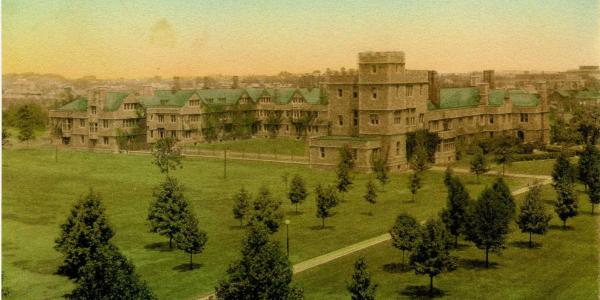
Anthropology Department History
The origins of our discipline and history of our building, McMillan Hall.

Anthropological concepts are first taught at WashU
The first explicit mention found of teaching anthropological concepts on this campus comes from the 1904-5 academic term, when Dr. Edgar James Swift, Education professor, in his class description for his “Introduction to the Philosophy of Education”, indicated that the course would, among other things, cover the results of anthropological research in relation to education. He taught this course for several years, always mentioning covering anthropological concepts in the course description.
Construction of McMillan Hall Begins
The university community gathered on October 20, 1906 to see W.K. Bixby, vice president of the board of directors and former business partner of William McMillan, break ground for a new building. On that autumn day, he spread mortar, using an engraved silver trowel, over the cornerstone of McMillan Hall. Standing over a century from its not-so-humble beginnings, this beloved building is home to the Department of Anthropology—and no archaeologists from Washington University have used silver trowels since. Funded by Mrs. Eliza McMillan, the millionaire widow of William McMillan, McMillan Hall opened in 1907 as the university's first women's dormitory. Dusty yearbooks, Student Life articles, alumni, and the building's own architecture continue to tell the tale of this historic building. It has hosted a range of activities—from annual May Fetes to top social scientists—and housed women, men, and machines. It was never a mere collection of rooms. Since its completion, McMillan Hall has inspired generations of talented individuals.
Anthropological Society of St. Louis is Founded
On January 2, 1920, local members of Section H (Anthropology) of the American Association for the Advancement of Science, founded the Anthropological Society of St. Louis, and Dr. Robert James Terry (1871-1966) was its first president. Meetings of this group were usually held in the seminar room of the ‘Anatomy and Physical Anthropology’ Department of the Medical School. Although many of the papers given at the Anthropological Society of St. Louis were on physical anthropology topics, due to Dr. Terry’s position and his recruitment of his students and colleagues from WUSTL and SLU medical schools, there also were papers given devoted to archaeology and socio-cultural anthropology. These meetings attracted individuals of national prominence; for example, Clark Wissler delivered a paper there on his book “Man and Culture” in 1923.
The First Department of Anthropology at WUSTL (1935-1945)
The first WUSTL incarnation of an Anthropology department was in 1935. At that point, the Arts and Sciences department which had been calling itself ‘Sociology-Anthropology’ split into two separate degree programs, with the university catalog explicitly listing separate faculty and separate curriculum for each section. The Anthropology faculty consisted of Luther Bernard, Walter Bodenhafer, George Mylonas, Stuart Queen, Lewis Thomas, and George Williams. This Anthropology division at WUSTL offered rather standard courses for the time such as the Introduction to Anthropology, Prehistory, Folkways, Human Geography, Race, Religion and Magic, and so on.
May Fete in the McMillan Courtyard, 1938
Perhaps McMillan Hall's most important social duty in its early years came as academic activity concluded each May. With the return of spring to St. Louis, the campus would buzz with anticipation of the annual May Fete, held in McMillan's courtyard. Today it may seem hard to relate to the pageantry of those nearly forgotten events, but throughout the first decades of the 1900s, and even leading into the early years of World War II, this spring blockbuster garnered excited reviews in Student Life and was a highlight of students' college experience. This annual production, put on by the university's female students, was complete with a May Pole dance, a theatrical presentation, and the all-important crowning of the May Queen. In 1928, the celebration saw the crowning of Miss Carol Crowe after a daisy chain processional of 50 women. In 1941, the same year that Count Basie played on campus ("part of a 'lecture' sponsored by the Department of Sociology and Anthropology," The Washington University Alumni Bulletin reports), the May Fete was particularly well attended. Spectators numbering more than 2,000 cheered for the crowning of Miss Alice Louise Stephens.
McMillan Hall in Wartime
In 1943, Adèle Starbird, dean of women and resident of McMillan Hall, saw her apartment, along with the rest of McMillan Hall, converted into quarters for Army engineers training and drilling on campus grounds. Between pages of "Washingtonians in the Armed Forces" in the June 1943 edition of The Washington University Alumni Bulletin, an announcement was made that McMillan Hall would house armed service personnel. By October 1943, some 2,000 Army students were living and training on campus.
Combined Sociology-Anthropology Department
The Anthropology section of the Sociology-Anthropology department had collapsed for all intents and purposes by 1942, although it was still listed as a separate section in the WUSTL catalog and documents through the 1945-46 academic year. The faculty of that last year were Queen, Bodenhafer, Bernard, Thomas, and Mylonas – three sociologists, a geographer, and a classical art historian. By the 1946-47 academic year, the department had officially re-combined with Sociology under the chairmanship of Queen, and was once again listed as a composite Sociology-Anthropology department
A Super (Sized) Computer
University resources were integral to the technology behind atomic fission in the 1940s and late 1950s. The university received another technological marvel: its first computer. The room-sized Univac was housed in McMillan Hall's former women's gymnasium. Jim Burmeister, who worked with IBM accounting machines and data cards as a student, recalls that professors or students wanting to use the computer would drop off their input cards in the evening and pick up the computed results the next morning.
Anthropology Becomes a Department (again)
John Bennett was elected by the department faculty, and then officially appointed by the administration, as the new chairman of Anthropology on November 1, 1967. In addition to Bennett as chairman, the department had two archaeologists (Patricia J. Lyon and Patty Jo Watson), two linguists (Marshall Elza Durbin and James R. Jaquith), two physical anthropologists (Stephen Molnar, and also counting Mildred Trotter at the Medical School, even though she had retired), two sociocultural anthropologists (Robert L. Canfield and Donald L. Souder), two other sociocultural anthropologists on leave (Valentine and Whitten, both of whom never returned), and two part-time members (Nelson A. Reed and Charles E. Thomas). The AAA Guide listing also claimed that the nascent department had 27 graduate students in residence.
Departmental Founding of Lambda Alpha
Our department established the ‘Beta’ chapter in Missouri of the anthropological honorary: Lambda Alpha. Our students have gone on to win the first graduate level research grant from this group, and our students also have competed for and received several other grants from Lambda Alpha over the years.
